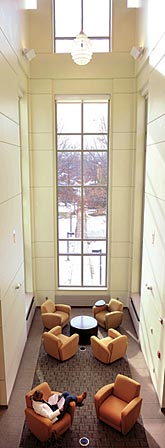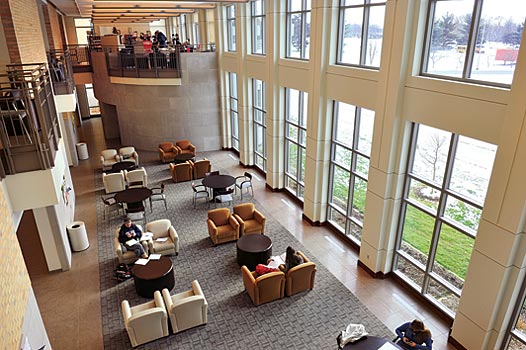Spes Unica: Plugged In and Part of a Community
By Natalie Davis Miller

A student reviews class work in one of the comfortable chairs found on the second floor of Spes Unica Hall.
From the rafters to the routers, the newest building on Saint Mary’s campus was built to help students stay plugged in and part of a community. The 68,000+-square-foot building houses 18 state-of-the-art classrooms, offices, laboratories, conference rooms, and a café. Faculty, students, and staff can access the outside world and each other through hardwired and wireless internet access.
High-tech doesn’t have to translate to isolated and disengaged. Saint Mary’s remains committed to the residential experience while it moves into the future with cutting edge technology. This commitment can be seen in the way technology campus-wide is put to use to bringing people together.
In Spes Unica Hall, basic technology in every classroom is the common denominator, according to Janice Thomasson, chief information officer in the information technology department. For example, all classrooms have access to computers with internet connection, DVD players, and what Thomasson says is a “hot” item that faculty have embraced—document cameras. Very much like an opaque projector, a professor can lay an object on it and the object will be projected onto a screen.
Two collaboratories, or high-tech classrooms, come equipped with a central touch panel, similar to a universal remote. “It turns on all of the equipment in one place without you having to go all over the room. That to me is probably the coolest,” says Thomasson.
Mary Connolly, professor of mathematics and management information systems, speaks highly of how the collaboratories are used in Spes Unica. Students work on a computer, and the professor has the ability to view their work from his or her computer, as well as share it with the rest of the class. “In our programs we focus on learning to work in a group, getting around a computer,” says Connolly. She sees Spes Unica as a “showcase” and adds that the technology in Spes Unica is seamless. “A professor doesn’t have to worry about how to use it—it’s very user friendly.”
Professor Connolly sees this kind of technology as having a real impact on students’ educational experience as well as their future. “We graduate people into fabulous jobs,” says Connolly.
Staying connected with the world is a priority met through the state-of-the-art videoconferencing equipment located in a meeting room in Spes Unica. The equipment is used in many ways, including staying connected to students participating in our study abroad programs.
The utility of high-tech, however, often depends on unplugged functionality. The furniture in Spes Unica received critical consideration. “We found out that configuring furniture is very important,” says Thomasson. “A lot of it isn’t even about the technology, it’s more about having furniture where you can move it around and easily get a bunch of students together quickly with their laptops.” Wireless internet access allows students to stay connected to the internet, as well as each other as they work on projects.
All of this new technology complements the existing technology at the College that professors use to bolster the residential experience. One such program is Blackboard, a learning management system, explains Dan Mandell, assistant instructor of instructional technology. Blackboard is a software program that facilitates interaction between students and their professors. It encourages small group work, allows for interactive feedback online, and it helps professors to evaluate students’ progress.
“It’s set up so that students can work collaboratively in groups, which is a little more motivating than struggling alone,” explains Mandell. “It facilitates collaboration— students can be in different locations, but working together on the same project.”
For professors, Blackboard is a tool that supplements their courses online. Psychology major Michelle Couri ’09 is required to use Blackboard for one of her classes. Even though she may be working from the comfort of her bedroom on her laptop, she’s staying connected to her professor and other students. “When you have a Blackboard discussion, you go online and you are basically able to take everything you’ve learned from class—lecture, readings, homework, all material involved—and it gives you a chance to collect information and take it in, then put it into your own words online with the group,” explains Couri. “It enhances learning because you have time to reflect—more time than you would sitting in class.”

Students study in the spacious atrium in Spes Unica Hall.
Renee Kingcaid, chair of the Department of Modern Languages, uses Blackboard as both a learning and assessment tool. “I use Blackboard in all of my courses to post daily class activities and homework, provide guidelines for test preparation, and guide the students to online resources for the course,” says Kingcaid. “Posting grades on Blackboard also allows students to follow their progress in the course, so that they know how they’re doing and when it’s time to come to me to look for extra help.”
Kingcaid also uses other existing technology on campus, such as the language labs in Regina Hall. “In language teaching and learning, the ability to connect with the real world in real time has been revolutionary. Students have already lost their old sense that language is ‘book learning,’ and know from their own experiences online that the world’s cultures all use different languages to communicate,” explains Kingcaid. “So the internet has given language teaching an immediacy that was never possible before.”
Kingcaid gives an example of learning expressions for weather in another language, and then being able to go online to find out more about that area. “We can get news, cultural pieces, and language practice exercises almost instantaneously. This is an enormous difference from the old model of relying primarily on the textbook and needing significant money and time to gather and disseminate similar materials to enhance the audio-visual component of the class,” explains Kingcaid. Nursing and business students are also studying language in the Interlangua Lab located on the library mezzanine. The lab is equipped with computers with Web cams and headsets, allowing students to converse with native Spanish speaking tutors in Guatemala.
Whether learning to speak a new language, working through a complicated equation, or collaborating as part of a group, students at Saint Mary’s reap the benefits of both cutting-edge educational technology and the personal attention that no technology can replace.

